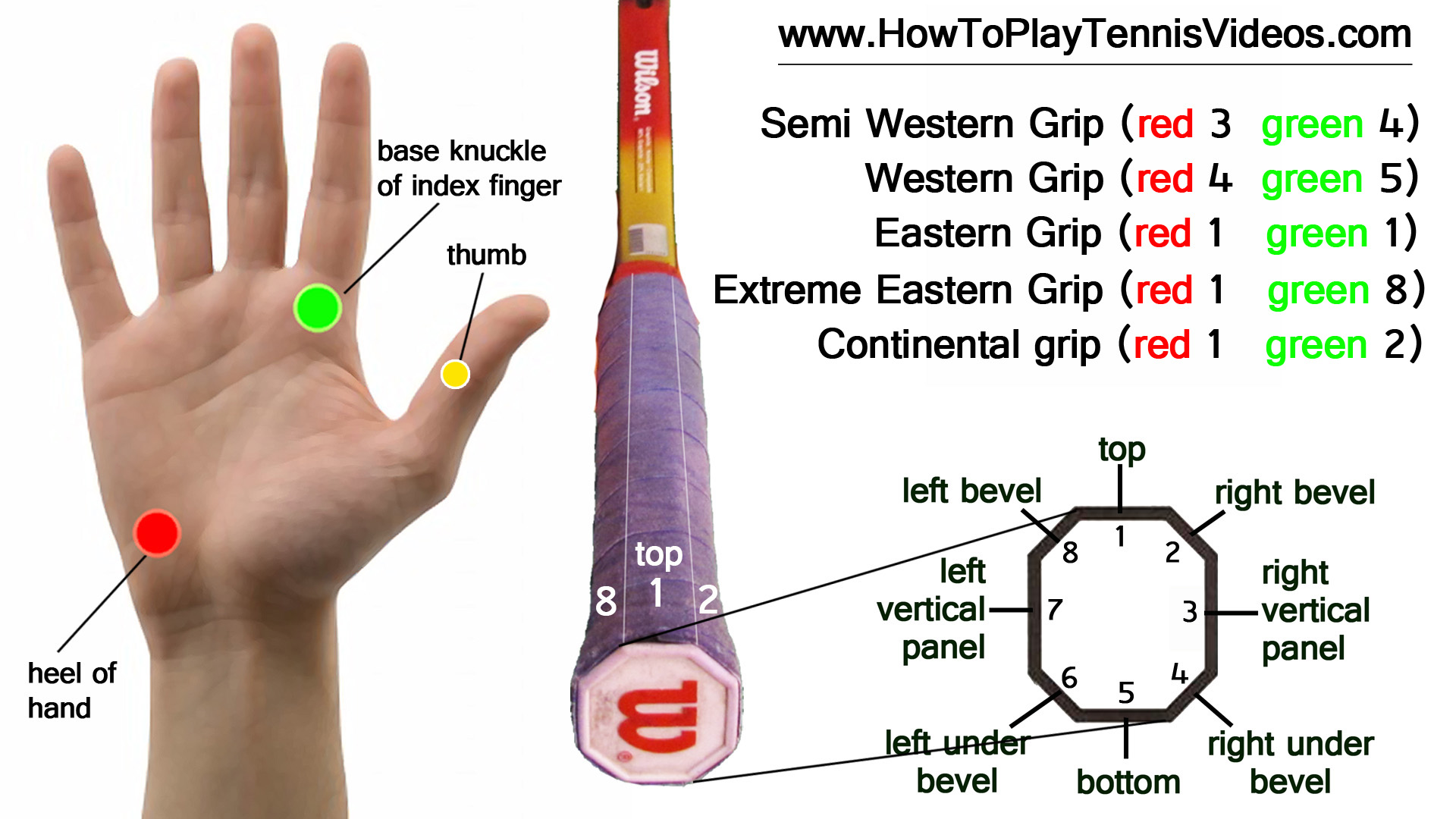General effect of different racket handle bevels and various hand reference points touching those bevels -
There are two reference points on the hand and there are two reference points on the racket handle. Common hand reference points are 1) index knuckle, 2) heel of hand, 3) little finger when wrapped around the handle, 4) other reference points on the hand are possible. Common racket handle reference points are bevel #, or fractional bevel for between bevels, and position along handle, 'butt', 'high up handle',etc..
A grip holds the racket to the palm of the hand. The wrist joint is nearby, separate from the hand. Assume the wrist is neutral and does not change for this demo and discussion. The wrist changes for the strokes and their impacts.
Demo -
1)
How Strings Face. Take a racket in your hand. Place the index knuckle on Bevel #2 and the heel of the hand also on Bevel #2. With a neutral relaxed wrist, look at the forearm-to-racket angle. Place your forearm on the arm of a chair or so that it does not move. (and wrist neutral). Now change bevel to #3 using the index knuckle and the heel of the hand. To Bevel #4. To #5. etc. What changes? That is what changing the bevel does.
It changes the angle of the face of the racket but it does not change the forearm-to-racket angle. How do we change that with the grip?
2)
Forearm-to-Racket Angle. Now place the index knuckle on bevel #2 and grip the handle so that it only reaches the little finger when comfortably gripped and palm touching bevel #2. What has changed now that the heel of the hand is not reached?
The forearm-to-racket angle has changed because of the new hand reference point.
Another way to change the forearm-to-racket angle is to use different bevels, for example, index knuckle on Bevel #2 and heel of hand on Bevel #1. You could also just move a fraction of a bevel, for example, use Bevel #2 and Bevel #1.5. The forearm-to-racket angle has changed because of the exact hand placement on bevels.
On the high level kick serve, impact occurs at a different forearm-to-racket angle, clear in high speed videos. It seems that the forearm-to-racket angle should be optimized for the kick serve and the angle of the racket strings should also be optimized. Often servers change grips for the kick serve but I have not found a description of why or details.
For other serving techniques, such as the Waiter's Tray, who knows how spin is applied or what grip is being used?
One issue is that the sizes of hands and racket handles are different.
I believe, but don't know, that the cook book 'bevel' grip descriptions, Continental, Eastern Forehand, etc, currently have problems and are not well described. The recommended grips probably only apply to the high level serving technique but the majority of players don't do the high level serve............The Tennis Serve Nuthouse.......
Adjusting the grip for the stroke is probably done by trial and error. The cook book descriptions are probably a good place to start if you are using a high level stroke technique.
For the high level forehand,
one hand backhand and the serve, the fat pad is most often not contacted by the hand. That's my opinion looking at high level stroke videos and pictures. But when I look at most instructions the 'fat pad' or 'heel pad' is used as a reference point. True or false?
Google:
tennis grips hand placement
https://www.google.com/search?q=gri...FeD4KHaNkDIIQsAQIHA&biw=1366&bih=891&dpr=0.87
Interesting thread dealing with this subject. Thanks Toly...
Discusses this issue in terms of "Pistol Grip" & "Hammer Grip".
Following the discussion of reply # 12, I held the racket from the index knuckle to the fat pad and then to the little finger wrap around area. The blue line represents bevel #2 to the fat pad. The red line represents bevel #2 to the area of the little finger. The two "T"'s at the ends of each line were traces of the end of bevel #2.
Here is how the hand looks without the racket. The white bar can be used for a direction reference.
This is bevel #2 resting on the fat pad, blue line. Note the angle between the forearm and the racket.
This is bevel #2 to the area where the little finger wraps around the butt of the racket, red line. Note the decreased angle between the forearm and racket. I measured the angular difference between the red and blue lines on the hand in the first picture with a protractor as 10 degrees.
The two figures shown are applicable to the forearm-to-racket angle on the serve.
In my opinion 10d. is a large angle in biomechanics and especially for the forearm-to-racket angle for the serve. One point is that the kick serve has a smaller forearm-to-racket angle at impact.








